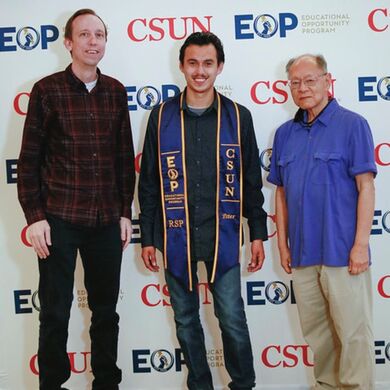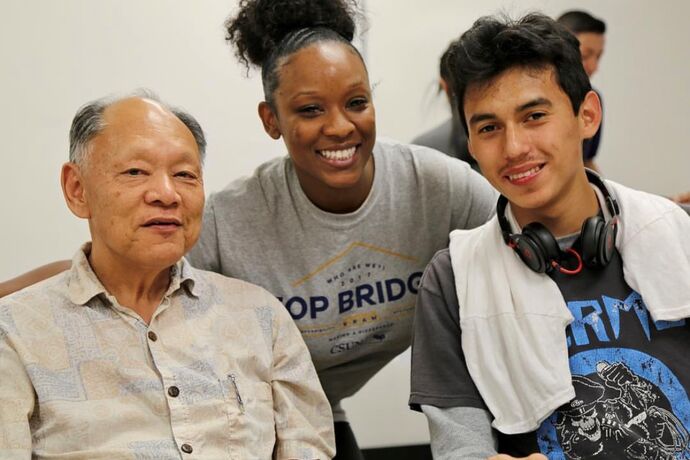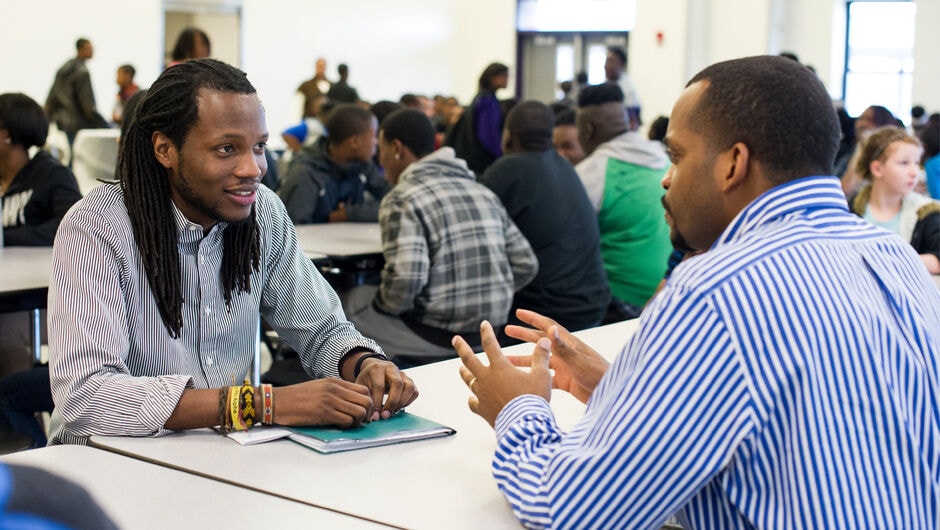
Targeted Support Is a Must to Rekindle Latinx College Completion Rates
More Latinx students were attending and graduating college before the coronavirus pandemic. To get students back on track, advocates are calling for more targeted investment in programs that help students get to and through college.
As a junior at California State University, Northridge, Peter Balvuena felt like he had found his footing on campus. He was participating in resource groups. He was attending office hours and talking to his professors after class.
Then the pandemic hit. Balvuena lost close family members and friends to COVID-19. He struggled to feel motivated to participate in remote classes because he was used to interacting with his professors and classmates in person.
It all felt like too much. Balvuena worried that his professors, particularly those teaching classes he needed for his major, wouldn’t understand what he was going through. He was intimidated to go to them for help, but he did it anyway.
“I told them ‘I can't, I'm mentally not there,’” Balvuena said.
The professors encouraged Balvuena to take the time he needed away from class to focus on his mental health. They extended assignment deadlines for him and continued to support him when he returned to class. Their support kept him from withdrawing from a course or dropping out.

Educators and other advocates have been working for years to topple college barriers for Latinx students by addressing issues such as affordability and a lack of information about navigating higher education. Some experts also say that greater collaboration between K-12 schools and institutions of higher learning can help boost college access and completion rates for Latinx students.
These types of support were important even before the pandemic, and they are crucial now. Latinx students, many of whom are first-generation college students and come from lower-income communities, are disproportionately weathering the challenges of the coronavirus pandemic.
For decades, Latinx students have been increasingly enrolling in and graduating from college—achievements that help pave paths to the middle class. From 2000 to 2019 alone, the number of Latinx students enrolled in post-secondary institutions increased from 1.5 million to 3.8 million, according to recently released research from Pew Research Center.
The effects of the pandemic are threatening to reverse that trend. College enrollment rates have declined for all students. Of Latinx students, nearly 11 percent planned to discontinue their college education in the fall of 2021, and many cited the inability to pay, according to the Latino Policy and Politics Institute at UCLA.
To help Latinx students achieve success in higher education, experts say interventions and support should begin long before they walk onto a college campus.
Get more articles like this delivered to your inbox.
The monthly ‘One Day Today’ newsletter features our top stories, delivered straight to your in-box.
Content is loading...
‘I Think You Care About People Like Me’
As a high school student, Balvuena was in foster care and had few resources for applying to colleges and accessing financial aid. When a school counselor refused to let him register for the SAT because she didn’t think he was cut out for college, Balvuena made a big decision to get the support he needed.
“I was like, ‘I got to get out of here,’” Balvuena said.
He transferred to another high school in his neighborhood: the Green Design Community School in Los Angeles. Teachers helped Balvuena register for college entrance exams with test fees waived. They also helped him complete the Free Application for Federal Student Aid, or FAFSA, wrote letters of recommendation and assisted him when he applied for California State University’s Educational Opportunity Program, which supports historically underserved students.
“They were like, ‘Nope, nope, nope, you're going to college,’” Balvuena said of the staff at Green Design Community School.
“Those things kind of helped me and made me feel safe. They’re helping students like me.”
Like Balvuena, Sofia Sastre was the first in her family to pursue a college education. But as an undocumented immigrant, Sastre immediately hit roadblocks when looking into financial aid options to afford school.
“You need to have a Social Security number and your parent’s income,” she said. “That kind of was the first point of me realizing that I was not even going to qualify for FAFSA.”
Sastre didn’t know who to turn to for help, and she worried that college might not be an option for her. Then she attended a recruiting event that Metropolitan State University of Denver, a Hispanic-serving institution, hosted at her high school. While researching MSU Denver, Sastre began to see a potential pathway to higher education.
MSU Denver had physical and virtual spaces with resources for undocumented and DACAmented students, including an immigrant services office and the Dreamer Zone, a portal on its website with a collection of relevant information. Those campus resources made Sastre feel comfortable talking about her immigration status and asking for help paying for college.
MSU Denver also provided health insurance that would have cost Sastre about $1,000 a year.
“Those things kind of helped me and made me feel safe,” said Sastre, who graduated in May with a bachelor’s degree in marketing. “They’re helping students like me.”
Making immigrant support resources easily accessible can go a long way toward helping undocumented students feel secure and supported in their higher education aspirations, said Luis Antezana (Colorado ’15), the founder of Juntos2College, an organization that supports undocumented students, parents, and educators.
“That's going to open up the ability for students to come out to their teachers, their administrators, school leaders, and tell them, ‘OK, I think it's safe enough for me to tell you this because I think you care about people like me,’” Antezana said.
Another common challenge for Latinx students—one that existed before the pandemic—is balancing coursework with their jobs. Many Latinx students have to juggle their studies with additional work and family responsibilities.
Interested in Joining Teach For America?
“The research shows that Latinos tend to work many more hours than their peers,” said Antonio Flores, president and CEO of the Hispanic Association of Colleges and Universities. “It really takes away from the time they need to put into their studies. They're going to need more money in financial aid to be able to get through college without having to work so many hours.”
Ces’Ari Del Muro (Phoenix ’10) worked three jobs while she was an undergraduate at the University of California Irvine. “Many of my peers who came from more affluent backgrounds didn't even have one job,” she said.
“Anyone who's juggling three jobs is going to struggle with time management and being able to find the time to sit and study,” Del Muro said. “They still overcome these challenges. But how amazing would their performance be if they didn't have to do all that?”
Supporting Latinx Undergrads Yields Strong Results for the Future
Another key to improving college graduation and retention rates is to address Latinx representation on campus. Diverse college faculty and enrollment can help Latinx students and other students of color feel that they belong in college.
“I could go all day without seeing anybody who looked like me,” Del Muro said. “I felt very, very, very isolated. As far as not seeing anybody who looks like you and not having representation, that's when imposter syndrome starts to creep in.“
Now, Del Muro runs Latinx Education Coach, a business she started with her husband, that offers editing services, academic and professional coaching, mentorship, and workshops about topics like overcoming imposter syndrome. Del Muro hopes that work will help more Latinx students pursue master’s and doctoral degrees like she did.
Officials at Hispanic-serving institutions like California State University, Northridge are working to boost college completion rates for Latinx students through programs that address inclusion and offer financial, academic, and health resources. As an undergraduate, Balvuena was a member of CSUN’s Resilient Scholars Program, which helps foster youths successfully navigate higher education, meet other foster youths on campus, and access campus resources.

He also benefited from the university’s Educational Opportunity Program office, which provides transitional resources that bridge the gap between high school and college for new students, along with academic and financial support services.
He attended virtual events to keep in touch with his peers during pandemic lockdowns. He also advised and supported freshmen who were struggling. Now, Balvuena is applying to graduate school and pursuing a career as a social worker.
Sastre was in her junior year and expecting her first child when schools and colleges shifted online at the start of the pandemic. At first, she worried about how the pandemic would affect her ability to continue her education, but she took remote classes and finished the semester. She stayed on track academically the next year even while pregnant with her second child.
Sastre also has big plans on the horizon: running a business. Early next year, she aims to start selling matching sets of children’s clothing that makes it easier for families to spot their kids in crowded places.
“I could never dream, coming to this country, that I was going to be an entrepreneur,” said Sastre, who is from Mexico. She wants to support her community and her family with the business skills she learned through college as well as the guidance she received through Juntos2College and Antezana’s mentorship.
To make sure more Latinx students complete college and find pathways to higher-paying careers, greater and more targeted investment is needed, some experts and politicians say.
For example, boosting investments in Hispanic-serving institutions could help more Latinx students graduate, pursue post-graduate education, and enter high-paying, in-demand fields such as STEM—science, technology, engineering and math—as well as medicine and education, said Flores of the Hispanic Association of Colleges and Universities.
“Congress needs to step up to the plate and invest in a more equitable way in HSIs because they really are the main driver for the future workforce preparation of our country,” Flores said.
In April, Sen. Alex Padilla and Rep. Joaquin Castro introduced in Congress the Hispanic Educational Resources and Empowerment Act, or HERE Act, which Flores said could be instrumental in addressing HSI funding gaps and improving Latinx college student outcomes. The bill proposes allocating $150 million to support partnerships and collaboration between HSIs and K-12 school districts with high enrollment of Latinx students.
Without that type of investment, Flores said, the nation “will suffer because we won't have enough highly-qualified professionals, technicians, and scientists to keep our economy moving forward.”
Sign up to receive articles like this in your inbox!
Thanks for signing up!
Content is loading...






